Samsung and Qualcomm announced late last week that they have increased 5G downlink speed by 20% by completing tests for 1024 Quadrature Amplitude Modulation (QAM) for both Frequency Division Duplex (FDD) and Time Division Duplex (TDD) spectrum bands. The former uses two different frequencies for transmitting and receiving while TDD uses a single frequency and separates transmitting and receiving by time.
QAM is an advanced modulation technology that relates to the amount of data (in bits) that can be sent over each transmission. The higher the QAM number, the more efficient a transmission is. While most commercial networks use 256QAM, 3GPP Release 17 calls for the use of 1024QAM. As Samsung notes, “This enhanced QAM technology helps operators maximize their use of spectrum resources and allows mobile users to seamlessly enjoy various mobile services such as live video streaming and online multi-player gaming, which require higher download speeds.”
The test took place at Sammy’s R&D lab in Korea using Samsung’s 5G vRAN software and radios supporting 2.1GHz (FDD) and 3.5GHz (TDD) bands. Qualcomm’s contribution included its phone form factor device which is equipped with the chip designer’s latest Snapdragon X75 5G Modem. This is the modem currently used on the
Samsung Galaxy S24 series and should also be used on the upcoming
iPhone 16 line later this year.
Samsung and Qualcomm deliver 20% faster 5G downlink speed using 1024QAM
Samsung and Qualcomm were able to deliver a downlink data speed of 485Mbps, 20% faster than the speed achieved using 256QAM. While this speed was achieved with a 20MHz bandwidth, using Carrier Aggregation, higher throughput can be created. Last year, Samsung and Qualcomm were the first to achieve a simultaneous 5G 2x uplink and 4x downlink carrier aggregation for FDD spectrum. Carrier Aggregation increases data transfer rates and results in faster downlink and uplink speeds.
To understand Carrier Aggregation, think about how fast traffic moves on a one-lane highway. Adding a second lane allows the highway to accommodate more traffic that can then move faster.
Sunil Patil, Vice President, Product Management, Qualcomm Technologies, Inc. says, “We are honored to have collaborated with Samsung on this industry first achievement. This accomplishment showcases our unwavering commitment to supporting operators in their efforts to enhance 5G throughput and boost spectral efficiency. By leveraging advanced QAM technology, we are empowering operators to maximize spectrum resources and deliver seamless, high-speed mobile services to 5G users.”
Source Link Website

